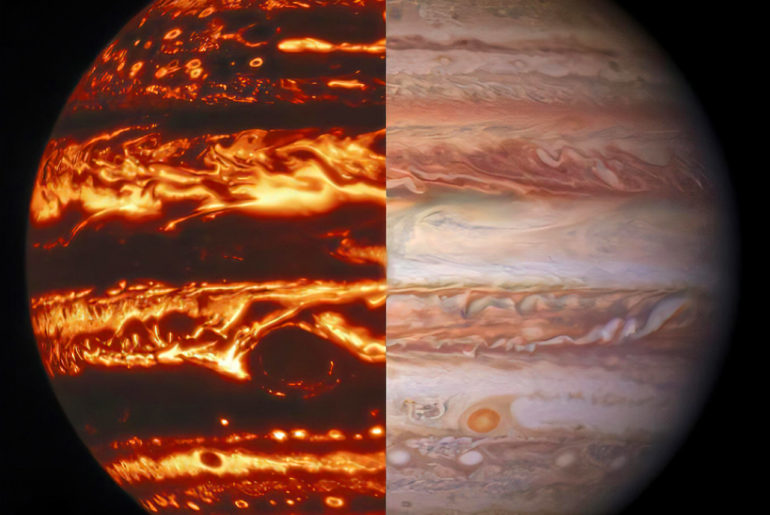
Photo credit: International Gemini Observatory/NOIRLab/NSF/AURA/NASA/ESA, M.H. Wong and I. de Pater (UC Berkeley) et al.
NOIR Lab has just released incredible new images of Jupiter captured by of Gemini North and the NASA/ESA Hubble Space Telescope that showcase the planet in infrared, visible, and ultraviolet light. These wavelengths of light reveal details in atmospheric features such as the Great Red Spot, superstorms, and the massive cyclones stretching across the planet’s disk.
When viewing the Great Red Spot at multiple wavelengths, you’ll be able to see that the dark region in the infrared image is larger than the corresponding red oval in the visible image. This happens because different structures are revealed by different wavelengths, as in the infrared observations reveal areas covered with thick clouds, while the visible and ultraviolet observations show the locations of chromophores, or the particles that give the Great Red Spot its famous hue by absorbing blue and ultraviolet light.
- BRIGHT, SHARP VIEWS ANYWHERE: Unlike many beginner telescopes, this quality refractor features fully coated glass lenses and a 70mm aperture for...
- PERFECT FIRST TELESCOPE FOR BEGINNERS: Designed for adults and kids to enjoy together, this beginner-friendly telescope sets up in minutes and...
- EASY NO-TOOL SETUP: No complicated assembly or tools needed. The full-height tripod and telescope tube set up in seconds and pack neatly into the...
The Gemini North observations were made possible by the telescope’s location within the Maunakea Science Reserve, adjacent to the summit of Maunakea. We are grateful for the privilege of observing Ka‘āwela (Jupiter) from a place that is unique in both its astronomical quality and its cultural significance,” said Mike Wong, the observation team’s leader, of the University of California, Berkeley.



